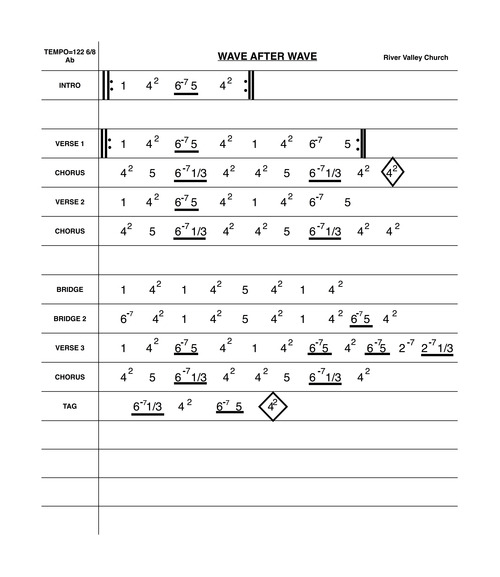

- #Downloadable nashville number system chart how to#
- #Downloadable nashville number system chart download#
So let’s go back to the Chromatic Scale chart, and apply these starting with D. If you remember in part one, we found the relationship between notes on the major scale to be
#Downloadable nashville number system chart how to#
Now we have to determine how to change or in musical terms “transpose” the song into the key of D. The relationship of the chords in the song is 1 – 6m – 5 – 4 repeated over and over. So you put on a Sherlock Holmes hat, and go back to the C major chart above to determine which numbers match the chords. But being the observant guitar player you are, you know that there is a relationship between the chords that stays the same, no matter what key you play in. If you didn’t know the relationship between the chords, you might be lost. the verses to Katheryn Scott’s song “Hungry” follow this progression) Now say your worship leader comes to you and says he or she would rather do the song in the key of D. Imagine having a chord chart in front of you of a song in the key of C… it repeats the chords C, Am, G, and F over and over. They’re called the Nashville Number System. These numbers (and ultimately the relationship they show) have a name in music circles. Now why are we mentioning the numbers 1,2,4,5 and 6, instead of just the chord names? The reason is the numbers show us the relationship between the notes and chords that are important to us. These five chords are very important in worship music, I’d go as far as saying that 80 percent of all worship songs contain only these chords or some variation of them. 4 or F has the name of “subdominant”, and 6 minor or A minor is called the “relative minor.” Some songs also include the 2 minor chord, (D minor) too. Obviously, 1 or C is important… in music terms, it’s called the “tonic.” Also, 5 or G is big, and it is called the “dominant.” note or chord. Working with the notes, there are a couple that have special importance. Those numbers show the relationship of notes (and also chords) to one another.

Pay careful attention to the numbers above each note, because they’re very important. You’ll remember that there are seven notes in the scale, so we’re going to show all the notes below and number them 1-7, starting with C (C is equal to 1, D is equal to 2, etc.): First, let’s look again at the C major scale. Now let’s get down and dirty with applying it. Those basic pieces of information are extremely important for growing as a guitarist. Ok, I first have to thank you for suffering through the last post. It’s a printable PDF with the chromatic scale wheel, a scale interval list, all the CAGED Chords, and the notes of the guitar neck in standard tuning. The Chord Number System will let you know exactly which chords you can try out that fall into that key.Download the Music Theory Chart that goes with this lesson. If you’re writing a song, and you’re starting out on a G chord, you can try different chord progressions to come up with interesting melodies and changes. It’s that simple – you can transpose any key to any other key you’d like using the chart.

So, go through your chord chart, and make the following changes to the chords: In the key of C, the 1, 4, 5, and 6 chords are C, F, G, and Am (respectively). Next, find the key you want to transpose to (let’s say you want to make it higher, so we’ll transpose it to E). If you want to transpose a song from one key to another, simply find the key that the song is in currently (let’s use C for an example). Here is where the fun starts… Transposing Find a key and look across – those are the chords (and what number they are) in that key. You’ll see a key signature to the right – this indicated which chords are sharp or flat.ĭown the left side of the document, you’ll see keys. Some chords are used more commonly than others, and these are denoted by color. Typically, the 2, 3 and 6 chords are minors, the 7 is typically a diminished, and the rest are majors. These represent the chords used in any given key.
#Downloadable nashville number system chart download#
When you download the document, you’ll see numbers across the top (one through eight). Ever wanted to learn music theory? Has a band-mate or musician told you to go to the 4 (or the 5, or the 2, or the 1), and you have no idea what that means? Want to be able to transpose a song to any key without even thinking about it? The Chord Number System is for you.


 0 kommentar(er)
0 kommentar(er)
